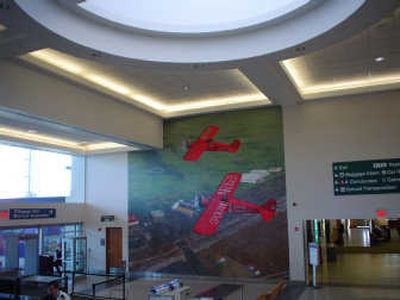Mural highlights local artist, city’s aviation history

A floor-to-ceiling mural depicting one of the great feats in Spokane aviation history adorns the entry to a main concourse at Spokane International Airport as part of a three-year project to upgrade the artistic appeal of the airport.
The acrylic painting by Spokane artist Tom Quinn was completed last fall in the first of four major art pieces being installed under the $300,000 project.
Quinn painted the mural from an original photograph of the 1929 aviation milestone by pilots Nick Mamer and Art Walker, who flew their single-engine Sun-God airplane from Spokane to New York via San Francisco and returned to Spokane without stopping on the five-day run. They refueled in flight by rendezvousing with other airplanes and receiving gas and oil through hoses. In one instance, gas was lowered in five-gallon cans. Food was also delivered midair.
The mural shows the bright red colors of the Sun-God and a second airplane, as well as the scene over Felts Field, which was the home base for the record-breaking journey.
“That story is just incredible,” said Dave Brukardt, a member of the airport board.
Three other contrasting art works are going to be installed in coming months, including whimsical airplanes by Ken Yuhasz, a large-scale glass sculpture by Steve Adams and fabric flying machines by Louise Kodis. Hers will go in the main rotunda.
All four Spokane artists are highly regarded, and their work was sought to show the vitality of the city’s visual arts culture, said Karen Mobley, arts director for the city.
“The airport is absolutely the front door to the community, and we as a community want to put our best foot forward,” Mobley said. “We want to show off some of our artists in that context.”
The project is being funded with $150,000 from the airport. In addition, Mobley and the Spokane Arts Commission are seeking an additional $150,000 through grants.
More than 50 art proposals were submitted when the airport and the Spokane Arts Commission started the project in 2006, said Brukardt, who is serving on the art selection committee for the project.
“We saw it as a real opportunity to showcase the flavor and talent and creativity of this area,” he said.
In addition to the four main art pieces, the project will include display cases to show off art by Spokane-area students, and other cases will show items from the Northwest Museum of Arts and Culture.
Sterling Savings Bank recently donated $15,000 to purchase the display cases for Spokane-area student art. Brukardt, who works in administration at the bank, helped secure that donation, he said.
Mobley said the student cases will be installed along the walkway connecting the rotunda with the C concourse.
Displaying youth art is intended to showcase Spokane as a family-friendly place, she said.
As part of Spokane history, the Sun-God mission was so widely acclaimed at the time that thousands of people turned out in New York when Mamer and Walker arrived there only to refuel and turn around. They did not land. An estimated 10,000 people flocked to Felts Field in Spokane for their return. During the journey, they survived severe thunderstorms, poor visibility from fog and forest fires and an accident in which a refueling hose was severed by the plane’s propeller. Advances in airplane technology and performance eliminated the need for in-flight refueling in commercial aviation, but the concept has been adopted by the military to extend the reach of U.S. air power.
Mamer died in a commercial airplane crash in Montana in 1938, but not before becoming one of the first American aviators to log 1 million miles in flight. He is commemorated by a clock tower at Felts Field, which predated Spokane International as the city’s air terminal. Felts is now used for general aviation.
Todd Woodard, spokesman for the airport, said the art should give people “a sense of who we are and what we do.”
Quinn did most of the mural painting during nighttime hours when passenger traffic had subsided.
A separate bronze plaque is going to accompany the mural. Its inscription says, Mamer and Walker’s “trip aboard the Spokane Sun-God set a precedent that helped shape the future of air travel.”